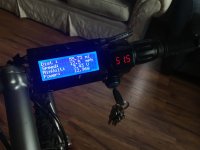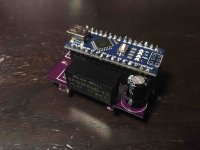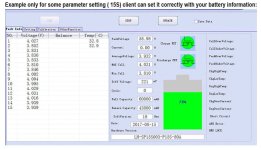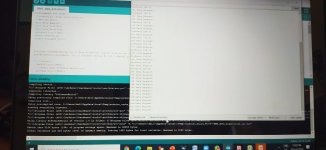fordtheriver
1 mW
- Joined
- Oct 27, 2018
- Messages
- 15
When looking for a BMS, I wanted to find one that could display pack data and power on a screen. I was so curious to see how much power my motor drew when riding along with my cell voltages. While there are BMS's out there that can do this, they are expensive and I found the JBD smart BMS and Simat's open source project on hacking into their communication protocol. Yes these are cheap Chinese BMS's, but this company seems to be pretty reputable and I haven't had any trouble. Anyways, thanks to the awesome work of Simat for explaining their UART communication protocol, I created an Arduino nano based system that reads data from the BMS and sends it to a 20x4 LCD screen.


If your BMS can be programmed with software that looks like this, then I believe it will be compatible with this project:

System Specs:
Receives individual cell voltages and pack current from BMS
Measures bike speed using a hall effect sensor and magnet on the wheel
Save mileage data to local memory on Arduino
Prints out mileage, current speed, the voltage of the lowest cell and power draw on LCD Display
Here's a link to my GitHub where you can find information on how to do this yourself. This technically has everything you need to implement this yourself but Arduino programming experience would be helpful as I don't have a lot of documentation on what I did. Either way, this is a great project to learn Arduino programming, UART, LCD displays and PCB design. If there's interest, I would be happy to further support this project. There is plenty of room for improvement and this seems to be one of the cheapest and most hands-on methods for making an ebike display!
Please let me know what you all think
tl;dr: If you are looking for a BMS to buy or already have a JBDTools compatible BMS, consider gleaning from this open source project to make a nifty ebike display.


If your BMS can be programmed with software that looks like this, then I believe it will be compatible with this project:

System Specs:
Receives individual cell voltages and pack current from BMS
Measures bike speed using a hall effect sensor and magnet on the wheel
Save mileage data to local memory on Arduino
Prints out mileage, current speed, the voltage of the lowest cell and power draw on LCD Display
Here's a link to my GitHub where you can find information on how to do this yourself. This technically has everything you need to implement this yourself but Arduino programming experience would be helpful as I don't have a lot of documentation on what I did. Either way, this is a great project to learn Arduino programming, UART, LCD displays and PCB design. If there's interest, I would be happy to further support this project. There is plenty of room for improvement and this seems to be one of the cheapest and most hands-on methods for making an ebike display!
Please let me know what you all think
tl;dr: If you are looking for a BMS to buy or already have a JBDTools compatible BMS, consider gleaning from this open source project to make a nifty ebike display.



